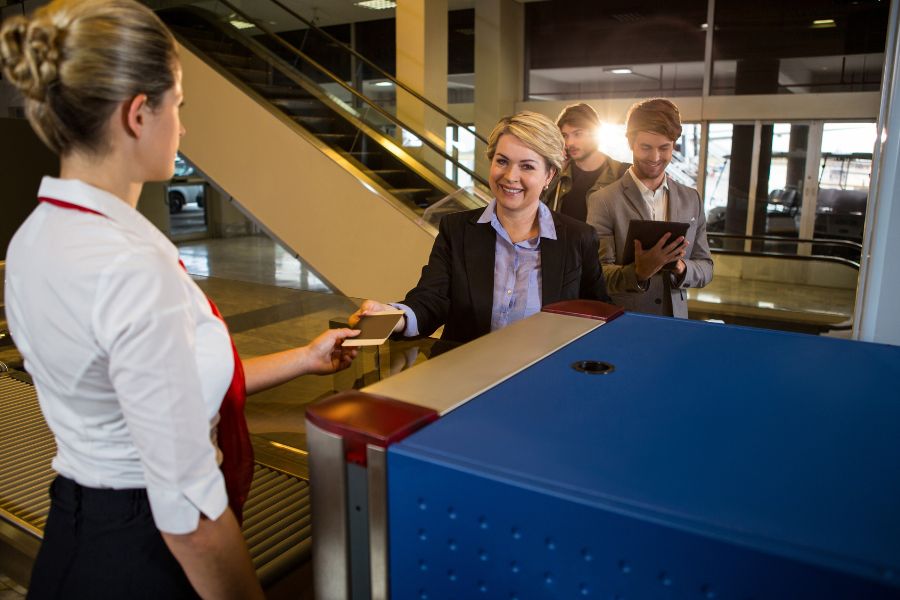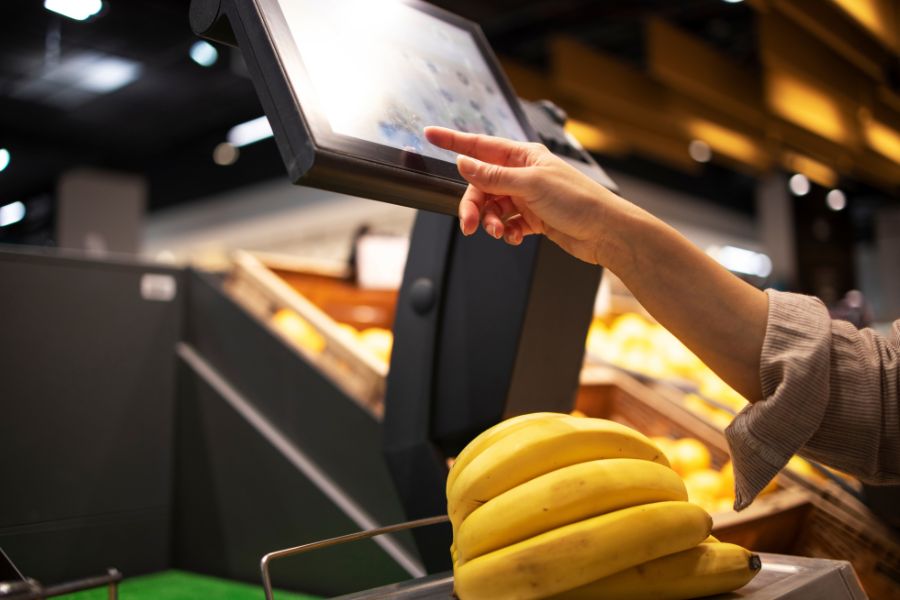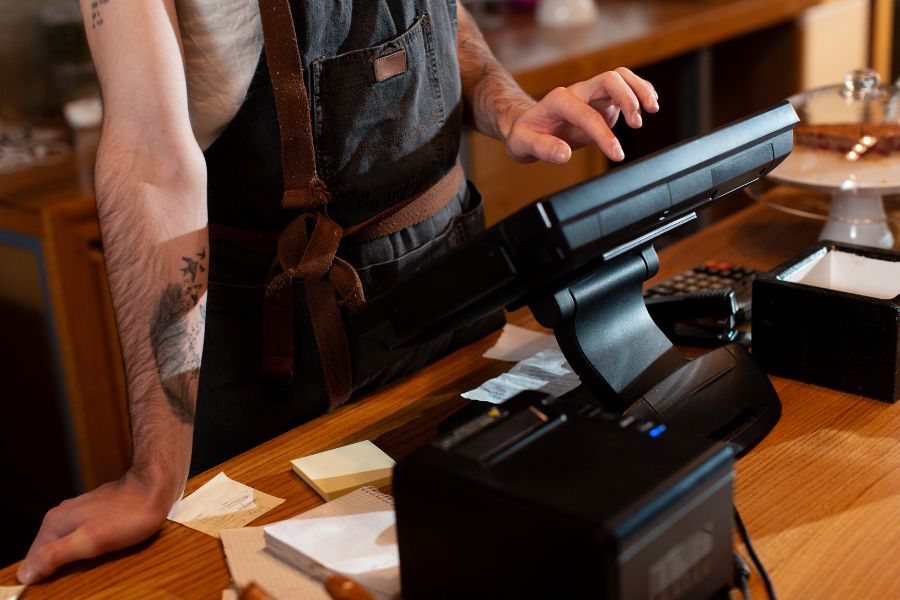Sporting events aren’t just ‘games’. They’re a full-on experience for fans, filled with energy, excitement, and unforgettable moments. But behind the scenes, there’s a lot that goes into making everything run smoothly. From selling tickets and managing crowds to keeping food stands stocked and merchandise flowing, organizers juggle countless moving parts. That’s where a modern point-of-sale (POS) system comes in. The right sporting event point of sale system connects everything in one place, syncing real-time inventory, enabling mobile payments, and helping staff keep up with fan expectations. In this post, we’ll break down what makes a great event POS, share tips on setting it up for success, and help event planners find the perfect fit for their needs.
Highlights:
- A sporting event point of sale keeps everything running smoothly by managing ticketing, tracking inventory, and speeding up transactions to avoid long lines at concessions and entry points.
- Smart practices with an event POS: Test devices beforehand, train staff on quick troubleshooting, use mobile POS units for faster service, and monitor live sales data to make real-time adjustments.
Characteristics of Sporting Event Point of Sale Systems
On a packed game day, fans want fast service, and staff need a system that can keep up with the rush. A well-designed sporting event point of sale helps handle high volumes of transactions in short bursts, ensuring that concessions, merchandise stands, and other sales points run smoothly.
One major advantage is flexibility in payment options. Many fans prefer credit cards or mobile payments over carrying cash, and modern POS systems accommodate both. Even better, roving staff with handheld devices can take orders on the go, reducing congestion at concession stands.
Key features include barcode scanning for quick merchandise sales, ticket system integration for in-seat purchases, and real-time inventory tracking. For larger venues with multiple vendors, a centralized system keeps stock levels updated across all locations, so fans aren’t stuck waiting for their favorite jersey or snack.
Many POS solutions also sync with event management software and ticketing platforms, giving organizers a complete view of revenue and inventory in one place. Built-in security features, like encryption and secure logins, help protect sensitive payment data.
By combining these capabilities, a modern POS system keeps transactions fast, lines short, and fans happy, all while giving event planners the tools they need to stay organized and efficient.
The Role of a POS System in Streamlining Sporting Event Operations
Running a sports event involves juggling countless tasks, scanning tickets, stocking concession stands, managing merchandise, and coordinating sponsor promotions. A modern sporting event point of sale brings these operations together under one tech framework, ensuring data flows seamlessly across departments. When ticket booths and concession stands share the same system, staff can track crowd movement and anticipate demand spikes in real time.
Nobody likes waiting in long lines, and a fast POS system helps keep them moving. Mobile-friendly devices allow vendors to take payments right in the stands, letting fans grab a snack or drink without missing the action. As transactions occur, the system automatically updates stock levels and sales data, helping managers predict peak times, adjust staffing, and open extra checkout lines when needed.
Beyond speed, a modern POS also improves accuracy. Instead of writing down orders or handling cash manually, staff can scan barcodes and process digital payments, reducing errors and making service more efficient. If a popular item runs low, stand managers can request a restock immediately or suggest alternatives, ensuring fans get what they want without frustration.
An advanced sporting event POS system enhances the overall experience, for both organizers and fans by streamlining operations, minimizing mistakes, and keeping service fast.
Best Practices for Using a Sporting Event Point of Sale System
Sports fans come for the action, the atmosphere, and, let’s be honest, the food and drinks. They expect fast service, whether they’re grabbing a hot dog before kickoff or picking up a souvenir after a big win. A reliable sporting event point of sale helps staff keep up with the rush from start to finish.
Before the Event: Set Yourself Up for Success
Preparation starts long before the gates open. Make sure every POS device is working properly, test all terminals, self-service kiosks, mobile units, and connections in advance. Staff should be comfortable logging in, troubleshooting common issues, and processing transactions quickly.
This is also the time to load up the system with menu items, special promotions, and accurate pricing. If ticket scanning is part of your setup, integrating it with the POS system can speed up entry at the gates. And don’t forget security, employees should know how to check IDs for alcohol sales and spot suspicious card activity. Managers and tech teams should double-check that product categories (food, drinks, gear) are labeled correctly to avoid pricing confusion when the crowds roll in.
A little preparation goes a long way in preventing last-minute chaos.
Game Time: Keep the Lines Moving
Once the doors open, speed and efficiency are everything. Mobile POS devices let staff take orders and payments directly in the seating areas, reducing congestion at fixed counters. Meanwhile, stationary registers should be ready to process transactions in seconds. If lines start getting too long, managers can shift staff around or open additional mobile stations to keep things flowing.
A real-time dashboard helps track stock levels on drinks, snacks, and merchandise. If supplies start running low, staff can reorder or direct fans to another stand with inventory. If the event offers loyalty perks, this is the perfect time to reward returning fans or members of a fan club. Keeping an eye on trends in crowd behavior, such as peak purchasing times or the most popular items, helps event organizers adjust on the fly, ensuring a smooth and enjoyable experience for everyone.
After the Event: Learn and Improve
Once the final whistle blows, it’s time to analyze how things went. The sporting event point of sale provides detailed sales data, showing which stands were busiest, what sold the most, and how efficiently staff handled transactions. Were some stands overwhelmed while others were quiet? Did mobile ordering make a difference? Should certain sections have more food and drink options next time?
Inventory reports will reveal whether supply estimates were accurate or if adjustments are needed for future events. This data-driven approach helps organizers fine-tune everything, from staffing and product offerings to promotions, so that each event runs even smoother than the last.
Steps to Choose and Implement the Right POS System
Selecting the right sporting event point of sale, from a broader perspective, it’s about keeping up with the fast-paced energy of the crowd, supporting multiple concession stands, and ensuring smooth transactions from start to finish. Here’s how to find and implement the best solution for your venue:
1. Identify Your Needs
Start by mapping out your venue’s specific requirements. How many stands and roaming vendors do you have? Do you need ticket-scanning capabilities or contactless payments? What about offline processing in case of network outages? The more details you define upfront, the easier it will be to narrow down your options.
2. Look for Essential Features
Speed is everything when serving fans during a big game. Choose a POS system that processes sales quickly, works seamlessly with barcodes, and keeps lines moving. Don’t overlook security, ensure the system meets industry standards for data protection and is compatible with your existing hardware.
3. Check Integrations
If your venue already uses a ticketing system or works with third-party food vendors, make sure your POS can sync with those platforms. The ability to share data across systems keeps inventory counts accurate, sales records consistent, and operations running smoothly.
4. Plan for Growth
A great POS system isn’t just about what works today, it should also support your future needs. Look for a solution that can scale with your business, whether that means adding more kiosks, expanding mobile ordering, or upgrading features with a simple software update.
5. Compare Pricing Models
POS providers offer different pricing structures, some charge a flat monthly fee, others take a cut of each transaction, and some require a one-time purchase. Weigh the pros and cons of each model to see what makes the most financial sense for your venue’s size and revenue flow.
6. Research Vendor Support and Reliability
In a high-pressure sports environment, technical issues can’t afford to slow things down. Read user reviews, check case studies, and assess the vendor’s reputation. A provider with responsive, 24/7 support can make all the difference when you need a quick fix during a packed event.
7. Train Your Team for Success
Even the best POS system is only as good as the people using it. Set aside time for staff training so they’re comfortable processing payments, handling partial refunds, and applying discounts. A practice run before the first big event can prevent slowdowns and confusion when it matters most.
8. Test Before You Go All In
Before rolling out your new system across the entire venue, start small. Try it at a lower-attendance event or in select concession stands. Gather feedback from staff, troubleshoot any hiccups, and refine the process. A phased launch helps ensure a smooth experience when the crowds get bigger.
Transforming Sporting Events with ConnectPOS
Big crowds, short timeframes, and countless points of sale, running a stadium’s sales operations is no small feat. That’s where ConnectPOS comes in. Designed specifically for sports venues, this cloud-based system simplifies daily workflows, speeds up transactions, and ensures every sale, from ticketing to concessions to merchandise, is seamlessly connected.
With ConnectPOS, organizers get a real-time, unified view of sales from the front gates to the farthest stands. Here’s how it transforms the game-day experience.
Key Features Built for Stadiums:
- Omnichannel Management: Syncs digital and physical sales so inventory updates happen instantly.
- Mobile POS Flexibility: Staff can use tablets for quick, on-the-go transactions in concourses and seating areas.
- Contactless Payments: Tap-to-pay and e-wallet options speed up checkout, reducing long lines.
- Offline Mode: No Wi-Fi? No problem. Transactions continue even if the network goes down, then sync automatically when back online.
- Multi-Location Management: Perfect for venues with multiple concessions, merchandise stands, and ticketing stations.
- Inventory Control: Track stock levels at every booth, see what’s selling fastest, and restock before supplies run out.
- Self-Service Kiosks: Let fans order and pay themselves, cutting wait times for those who prefer a quick, contact-free experience.
- Loyalty & Promotions: Reward repeat fans and group ticket buyers with exclusive discounts and deals.
With ConnectPOS, stadiums operate more smoothly, staff work more efficiently, and fans spend less time waiting in line. Whether it’s ticket scanning, concession sales, or merchandise purchases, everything flows through a single, powerful system. Plus, built-in analytics provide valuable insights into top-selling items, peak transaction times, and trends that help venues plan smarter for future events.
The result? Happier fans, faster transactions, and a more profitable stadium experience.
FAQs: Sporting Event Point of Sale
1. How does a POS system improve fan experience at sporting events?
A good POS system helps fans spend less time in line and more time enjoying the game. With faster transactions, self-checkout kiosks, and mobile POS devices, purchases happen quickly, whether at a concession stand or right from their seats. Digital payments like tap-to-pay and e-wallets make checkout seamless, so fans can grab what they need and get back to the action without missing a beat.
2. Can ConnectPOS integrate with ticketing systems and stadium vendors?
Yes. ConnectPOS works with many popular ticketing platforms and stadium vendors, keeping everything in sync. When a fan scans their ticket at the entrance, the system tracks the data behind the scenes. Meanwhile, any concession stand purchase updates inventory in real time, ensuring smooth operations from check-in to checkout.
3. Is ConnectPOS suitable for both small and large sporting events?
Absolutely. Whether it’s a local tournament or a packed stadium, ConnectPOS scales to fit your needs. Smaller events benefit from real-time stock tracking and streamlined transactions, while larger venues can manage multiple stands and devices effortlessly. The system’s intuitive interface makes training easy for new staff, and the flexible hardware options, from full registers to handheld tablets, let you customize the setup to match your event’s layout.
Final Thoughts
Fans come together to see top-level action and team spirit. A sporting event point of sale ensures shorter lines, accurate tabulations, and informed decisions about staffing and inventory. Real-time insights let operators respond to shifting crowd demands, and integrated payment options keep fans content. A robust POS provides a single platform for gates, concessions, and merchandise. ConnectPOS offers sports venues a scalable, easy-to-integrate system designed to handle hectic conditions.
Interested in a more streamlined service for your event? Reach out to us and learn how ConnectPOS can transform your next match or tournament so attendees walk away pleased and ready to return.
ConnectPOS is a all-in-one point of sale solution tailored to meet your eCommerce POS needs, streamline business operations, boost sales, and enhance customer experience in diverse industries. We offer custom POS with features, pricing, and plans to suit your unique business requirements.




